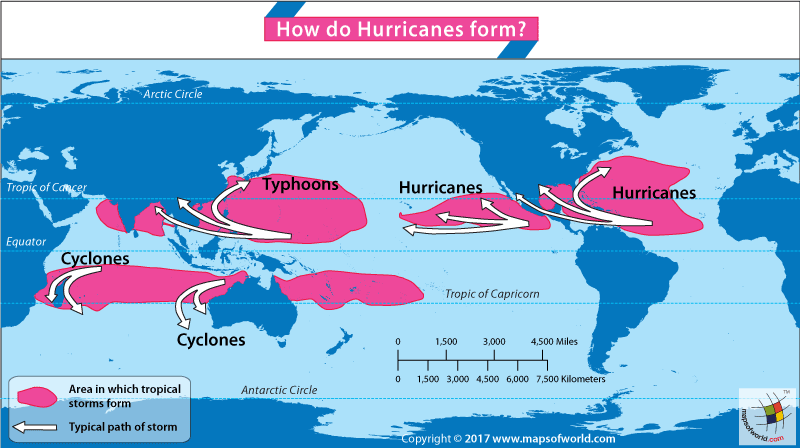

Tropical storms in the Atlantic and the Northeast Pacific are called Hurricanes, in the Northwest Pacific Typhoons, and the same are called Cyclones in the South Pacific, and the Indian Ocean
Hurricanes are rather large and severe tropical storms that form over the warm waters of the North Atlantic Ocean, particularly in the Caribbean Sea and the Gulf of Mexico. Hurricanes may also form over the northern, eastern, and southern Pacific Ocean. They are accompanied by swirling winds at very high speeds (usually between 74 and 136 miles per hour). Hurricanes often bring heavy rains, lightning, and thunderstorms. They can cause much damage when they strike land. Hurricanes also cause sea surges – a flood that often inundates the coastal areas by water that is pushed ashore by the storm – sometimes referred to as a ‘wall of water.’ Hurricanes can be large storms stretching up to 600 miles.
From Disturbance to Hurricane
Scientists and meteorologists say that there are three factors that lead to the formation of a hurricane – warm ocean waters, overhead clouds, and a high humidity/moisture levels, in the region where these hurricanes are formed. They often start out as a tropical disturbance that builds over warm ocean waters. The warmth of the waters fuels the disturbance with the energy needed for it to escalate into a storm, and potentially turn into a hurricane. These storms form over oceans where the surface temperature is over 79 degrees Fahrenheit, or about 26 degrees Celsius.
Another factor that leads to the formation of hurricanes is winds that blow at steady speeds without dissipating the storm. These winds start to rotate around what becomes the Eye of the storm. This core region has light winds and remains relatively clear while thunderstorms swirl around it. When the wind speeds of a tropical disturbance are less than 38 miles per hour, they are referred to as tropical depressions. When wind speeds are higher, they come to be known as tropical storms. A tropical storm escalates into a full-blown hurricane when its wind speeds reach 74 miles per hour.
Formation of A Hurricane
Tropical Cyclones and Typhoons are weather phenomena that are similar to Hurricanes. Severe storms that develop over the western Pacific are called Typhoons and those forming over the Indian Ocean are called Tropical Cyclones.
Know more:
Related Maps:
The Republic of Madagascar is an island country located in the Indian Ocean, off the…
The Euro is the official currency of the European Union. It is, however, not incumbent…
There are many countries or regions that are partially recognized by the UN, have disputes…
The Alaska Statehood Act was signed into law by President Dwight D. Eisenhower in 1958,…
The name Persia may, however, only be used to refer to Iran in some contexts.…
Hawaii is an Island State in the US. It is one of the 50 states…